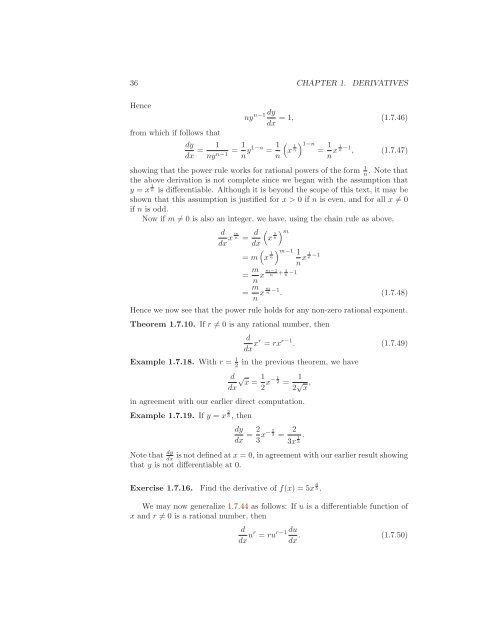Yet Another Calculus Text, 2007a
Yet Another Calculus Text, 2007a
Yet Another Calculus Text, 2007a
You also want an ePaper? Increase the reach of your titles
YUMPU automatically turns print PDFs into web optimized ePapers that Google loves.
36 CHAPTER 1. DERIVATIVES<br />
Hence<br />
from which if follows that<br />
n−1 dy<br />
ny =1, (1.7.46)<br />
dx<br />
dy<br />
dx = 1<br />
ny n−1 = 1 n y1−n = 1 ( ) 1−n<br />
x 1 1<br />
n =<br />
n<br />
n x 1 n −1 , (1.7.47)<br />
showing that the power rule works for rational powers of the form 1 n<br />
. Note that<br />
the above derivation is not complete since we began with the assumption that<br />
y = x 1 n is differentiable. Although it is beyond the scope of this text, it may be<br />
shown that this assumption is justified for x>0ifn is even, and for all x ≠0<br />
if n is odd.<br />
Now if m ≠ 0 is also an integer, we have, using the chain rule as above,<br />
d<br />
dx x m n<br />
d<br />
(<br />
=<br />
dx<br />
= m<br />
) m<br />
x 1 n<br />
(<br />
x 1 n<br />
) m−1 1<br />
n x 1 n −1<br />
= m n x m−1<br />
n + 1 n −1<br />
= m n x m n −1 . (1.7.48)<br />
Hence we now see that the power rule holds for any non-zero rational exponent.<br />
Theorem 1.7.10. If r ≠ 0 is any rational number, then<br />
d<br />
dx xr = rx r−1 . (1.7.49)<br />
Example 1.7.18. With r = 1 2<br />
in the previous theorem, we have<br />
d √ 1 x =<br />
dx 2 x− 1 1<br />
2 =<br />
2 √ x ,<br />
in agreement with our earlier direct computation.<br />
Example 1.7.19. If y = x 2 3 ,then<br />
dy<br />
dx = 2 3 x− 1 2<br />
3 = .<br />
3x 1 3<br />
Note that dy<br />
dx<br />
is not defined at x = 0, in agreement with our earlier result showing<br />
that y is not differentiable at 0.<br />
Exercise 1.7.16. Find the derivative of f(x) =5x 4 5 .<br />
We may now generalize 1.7.44 as follows: If u is a differentiable function of<br />
x and r ≠ 0 is a rational number, then<br />
d<br />
dx ur = ru<br />
r−1 du<br />
dx . (1.7.50)


















